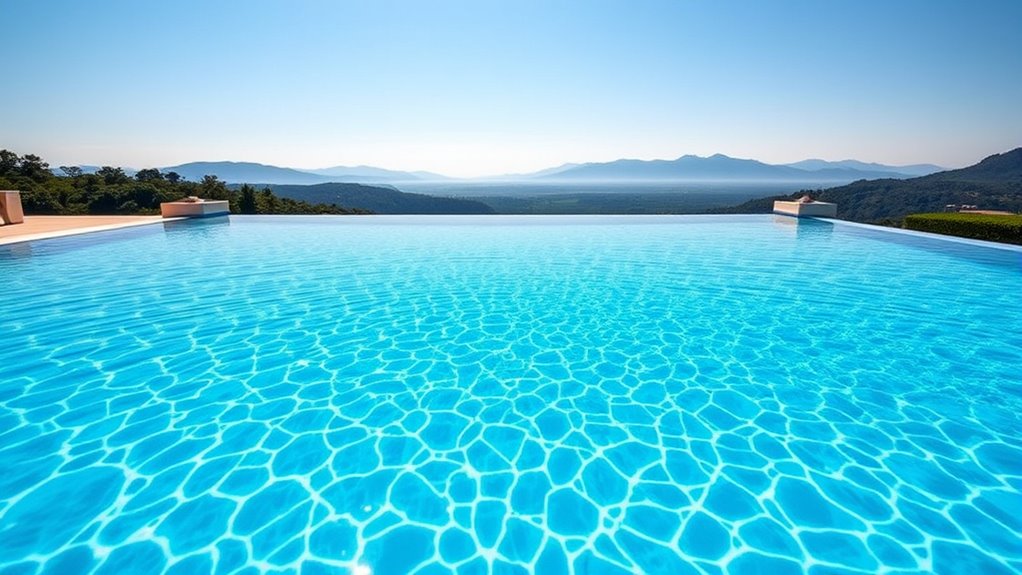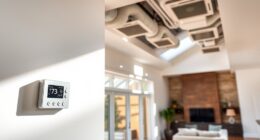To protect your infinity pool’s plaster and tile edges, keep the LSI balanced by monitoring water chemistry regularly. Maintain your pH between 7.2 and 7.8, and alkalinity at 80-120 ppm to prevent scaling and etching. Control calcium hardness to avoid deposits that can damage surfaces. Proper adjustments help prevent deterioration and keep edges smooth. Keep these tips in mind, and you’ll discover how ideal LSI control can extend your pool’s lifespan and beauty.
Key Takeaways
- Regularly monitor and adjust pH, alkalinity, and calcium hardness to maintain a balanced LSI, preventing scaling and etching at edges.
- Keep LSI within the ideal range (around 0) to minimize calcium carbonate deposits that damage plaster and tile edges.
- Use reliable testing methods and calibrated instruments for accurate water chemistry measurements.
- Avoid sudden chemical changes; make gradual adjustments to sustain long-term water balance and edge protection.
- Consistently follow water balancing guidelines to prevent corrosion, scaling, and deterioration of pool edges.
Understanding the Role of LSI in Pool Water Chemistry
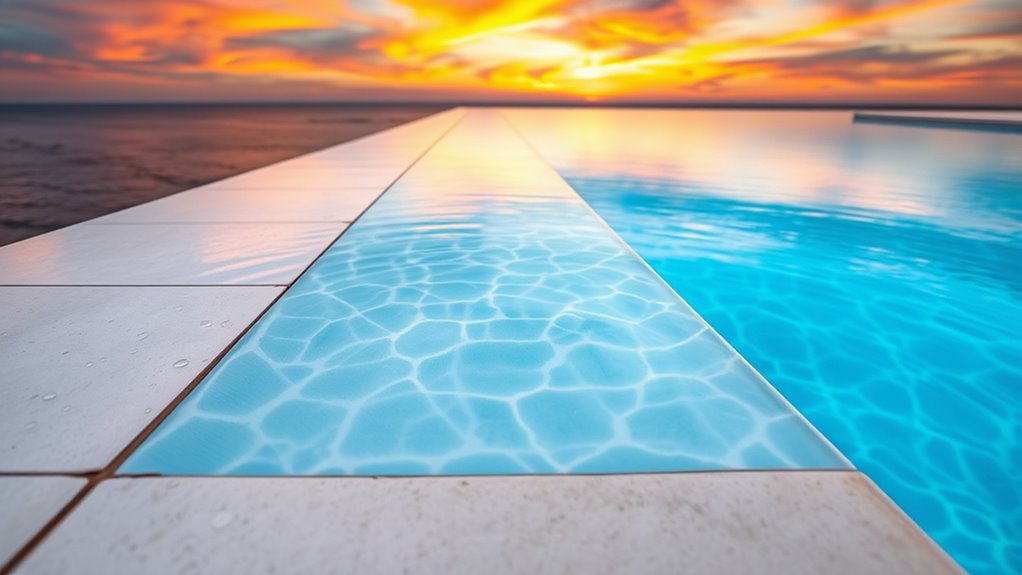
Understanding the role of LSI in pool water chemistry is essential for maintaining clear, balanced water in your infinity pool. LSI, or Langelier Saturation Index, measures whether your water is corrosive, balanced, or scaling. When the LSI is too low, your water becomes corrosive, risking damage to plaster, tiles, and equipment. Conversely, if it’s too high, the water becomes scaling, leading to deposits on surfaces and plumbing. Maintaining a proper LSI guarantees your pool’s water chemistry stays stable, protecting your pool’s surface and infrastructure. To keep the LSI balanced, you adjust pH, alkalinity, calcium hardness, and temperature. Regular testing and tweaking these parameters help you prevent issues, prolonging the life of your pool’s materials and ensuring crystal-clear water for your infinity pool experience. Additionally, understanding water chemistry balance is vital for preventing damage and optimizing water quality.
How Imbalanced LSI Affects Plaster and Tile Edges
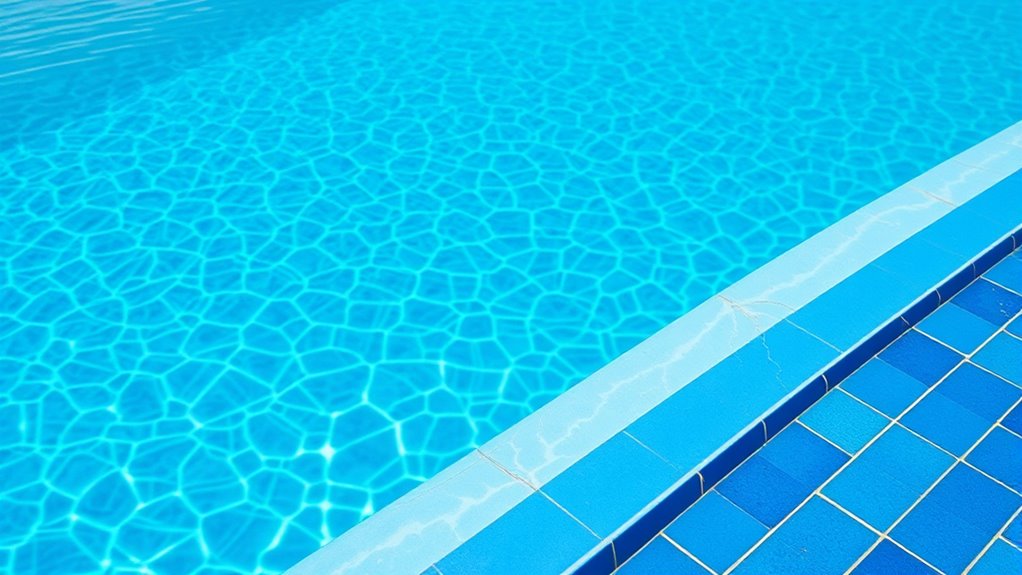
When your LSI is off balance, the edges of your plaster and tiles become more vulnerable to wear and damage. You might notice cracks or chipping starting to form where the materials meet. Over time, this imbalance can also weaken the sealant, leading to leaks and costly repairs. Maintaining proper digital literacy at home can help prevent overlooked issues and promote timely maintenance.
Edge Wear and Damage
Imbalanced LSI levels can cause significant edge wear and damage to the plaster and tiles of your infinity pool. When the LSI is too high or too low, it creates stress concentrations at the edges, leading to deterioration. This imbalance accelerates erosion, causing chips, cracks, and surface spalling. Over time, the structural integrity of the edges weakens, resulting in costly repairs. Proper LSI balance preserves the longevity of your pool’s edges by minimizing these issues. To maintain ideal conditions, consider these factors:
- Consistent water chemistry
- Proper pH levels
- Adequate alkalinity
- Correct calcium hardness
- Regular water circulation
- Monitoring projector contrast ratio to prevent visual distortion and ensure clear edge definition.
Sealant Effectiveness Decline
If the LSI is out of balance, the sealants around your pool’s plaster and tile edges can lose their effectiveness more quickly. When the LSI is too high or low, it creates a harsh environment that accelerates the breakdown of sealants. An imbalanced LSI causes excessive moisture movement, leading to cracks and gaps in the sealant material. These gaps allow water to seep behind tiles and into the plaster, weakening the structure over time. As sealants deteriorate, your pool edge becomes more vulnerable to water infiltration and damage. This not only reduces the lifespan of the sealant but also increases maintenance costs. Maintaining a proper LSI ensures your sealants stay effective longer, protecting your pool’s edges and preventing costly repairs. Proper water chemistry is essential for the overall health of your pool, including the longevity of sealants and plaster.
Monitoring and Testing LSI Levels in Infinity Pools
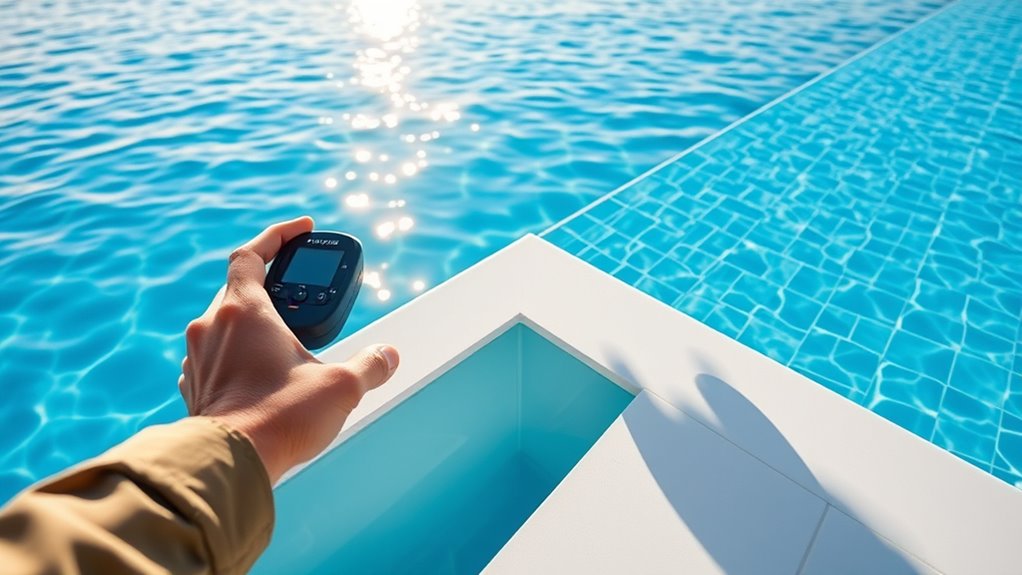
Are you regularly monitoring and testing the LSI levels in your infinity pool? Keeping a close eye ensures the water chemistry stays balanced, preventing damage to plaster and tile at the edge. Use reliable testing kits or digital sensors to measure key parameters like pH, temperature, calcium hardness, and alkalinity. Regular testing allows you to detect fluctuations before they cause costly issues.
A user-friendly interface in testing apps or devices can simplify the process and improve accuracy.
Consider these critical factors:
- Test water at different times of day to account for temperature changes
- Record results to track trends over time
- Use calibrated instruments for accuracy
- Maintain consistent testing intervals, especially after chemical additions
- Cross-check test results with professional lab analysis periodically
Staying vigilant helps you maintain ideal LSI levels, protecting your pool’s integrity.
Adjusting Ph and Alkalinity to Maintain Proper LSI
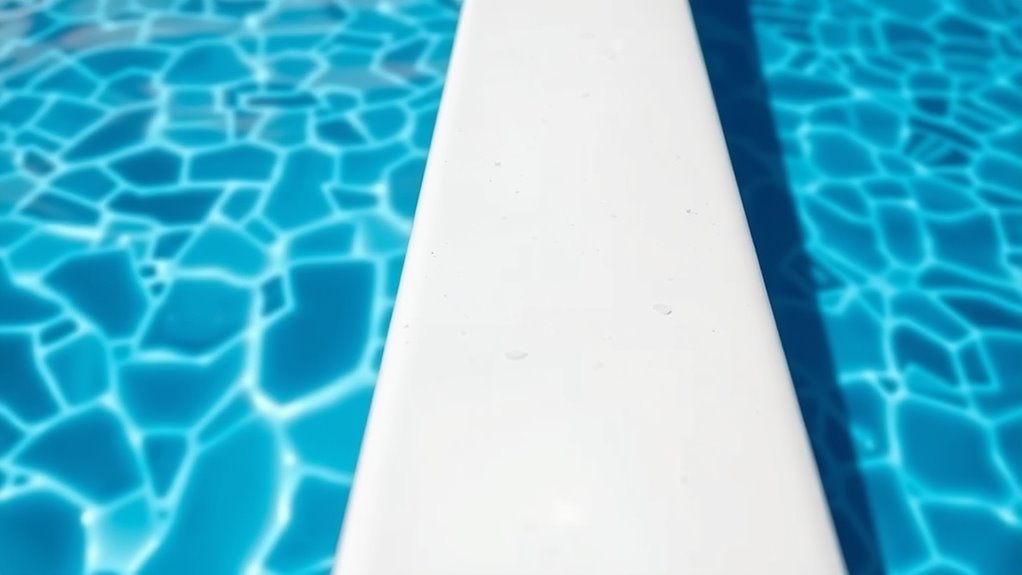
To effectively maintain proper LSI levels in your infinity pool, you need to carefully adjust the pH and alkalinity. Start by testing your water regularly to identify current levels. If pH is above 7.8, add a pH reducer; if below 7.2, add a pH increaser. For alkalinity, aim for 80-120 ppm. If it’s too high, use a reducing agent; if too low, add alkalinity increaser. Use the table below to guide your adjustments:
| Current Level | Action |
|---|---|
| pH > 7.8 | Add pH reducer |
| pH < 7.2 | Add pH increaser |
| Alkalinity > 120 ppm | Add alkalinity reducer |
| Alkalinity < 80 ppm | Add alkalinity increaser |
Consistently balancing these parameters helps keep your LSI in check, preventing damage to the plaster and tile edges. Regular testing and adjustment are essential for proper pool maintenance.
The Impact of Calcium Hardness on Edge Durability
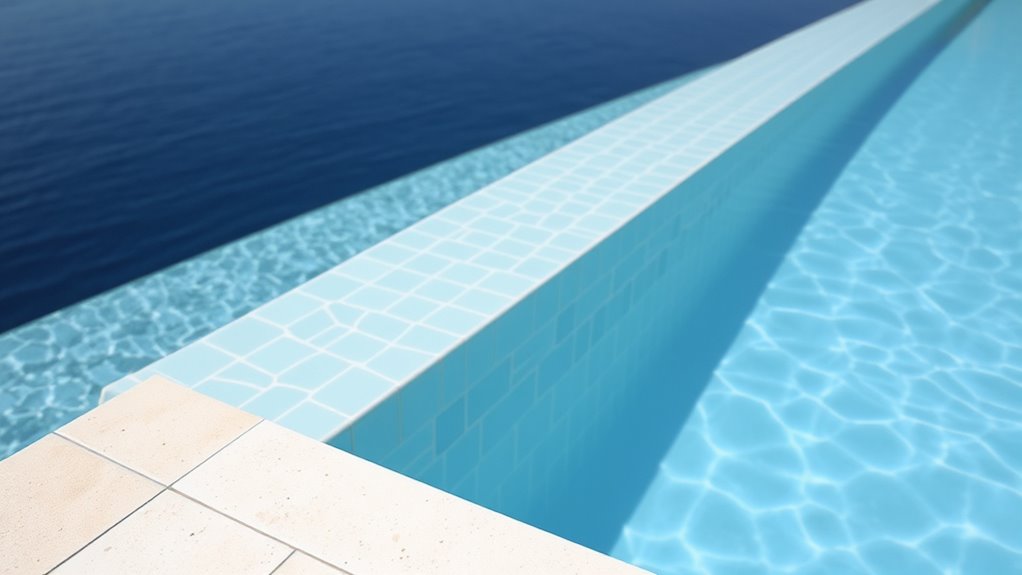
Calcium hardness levels directly affect your pool’s edges by influencing scale formation. When hardness is too high, calcium deposits can build up and weaken the edge materials. Maintaining proper calcium levels helps prevent damage and extends the durability of your infinity pool’s edges. Regular testing and water chemistry management are essential to ensure optimal calcium hardness and protect your pool’s structure.
Calcium Scale Formation
When calcium hardness levels are high, mineral deposits can quickly form on the edges of infinity pools, leading to calcium scale buildup. This scale creates a rough, unsightly surface that can weaken the plaster and tile over time. It also impairs water flow, potentially causing staining and damage to adjacent materials. To minimize scale formation, consider:
- Regularly checking and adjusting calcium hardness levels
- Using appropriate water conditioners and sequestrants
- Maintaining proper pH balance to prevent precipitation
- Implementing routine cleaning and descaling protocols
- Installing scale inhibitors or LSI control devices
- Monitoring water chemistry closely to ensure optimal balance
Addressing calcium scale proactively preserves the integrity of your pool’s edges, ensuring long-lasting durability and a pristine appearance. Proper water chemistry management is key to preventing calcium deposits from compromising your infinity pool’s edge features.
Hardness Levels Impact
High calcium hardness levels can considerably weaken the edges of your infinity pool by promoting mineral buildup and scale formation. Excess calcium creates a rough surface, leading to cracks and tile delamination over time. When calcium levels are too high, scaling reduces water flow and increases stress at the edges. To prevent damage, maintain calcium hardness within the recommended range. Monitoring your water chemistry regularly helps ensure balanced calcium levels and prolongs the life of your pool edges.
Preventing Scaling and Etching Through Proper LSI Management
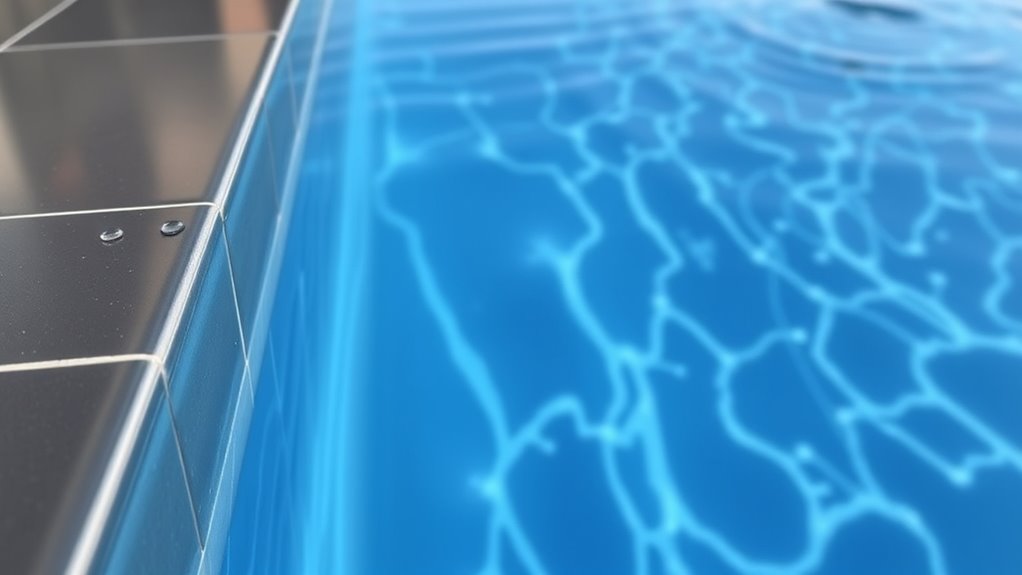
Because proper LSI management is crucial, maintaining an ideal LSI level helps prevent both scaling and etching in your infinity pool. When the LSI is too high, calcium carbonate deposits form, leading to unsightly scaling on plaster and tile surfaces. Conversely, if the LSI is too low, aggressive water can dissolve plaster and tile, causing etching and surface damage. To keep your pool balanced:
Maintaining optimal LSI levels prevents scaling and etching, protecting your pool’s surface and extending its lifespan.
- Regularly test water chemistry to monitor LSI levels
- Adjust pH and alkalinity to maintain balance
- Control calcium hardness to prevent over-saturation
- Use chemical treatments to fine-tune the LSI
- Avoid sudden chemical changes that disrupt stability
- Incorporate proper water balancing practices to sustain optimal LSI levels
Maintaining the right LSI ensures your pool’s surface remains smooth and intact, safeguarding your investment and enhancing longevity.
Best Practices for Regular Water Chemistry Maintenance
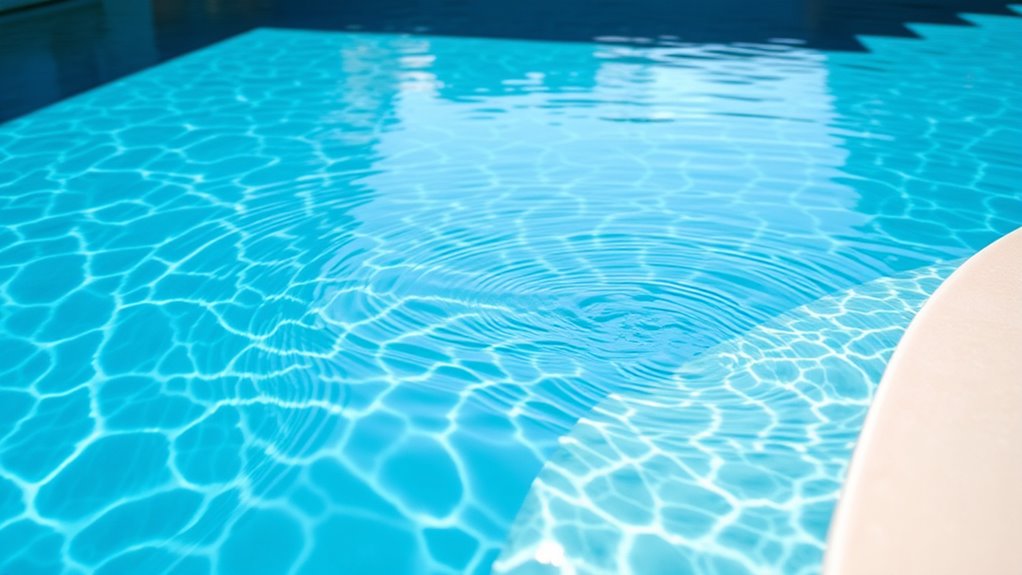
Maintaining proper water chemistry is key to keeping your infinity pool balanced and preventing issues like scaling or etching. Regularly test your water’s pH, alkalinity, and calcium levels with reliable test kits. Aim for a pH between 7.4 and 7.6 and maintain alkalinity around 80-120 ppm. Keep calcium hardness within 200-400 ppm to prevent scaling or etching of plaster and tile. Shock the pool weekly to eliminate contaminants and algae. Use appropriate sanitizers—chlorine or bromine—to maintain a consistent residual level. Adjust chemical levels promptly based on test results, especially after heavy use or rain. Consistent maintenance ensures ideal water balance, protecting your pool’s surface and extending its lifespan. Regular checks and adjustments are essential for a healthy, beautiful infinity pool.
Long-Term Benefits of Maintaining Correct LSI Levels
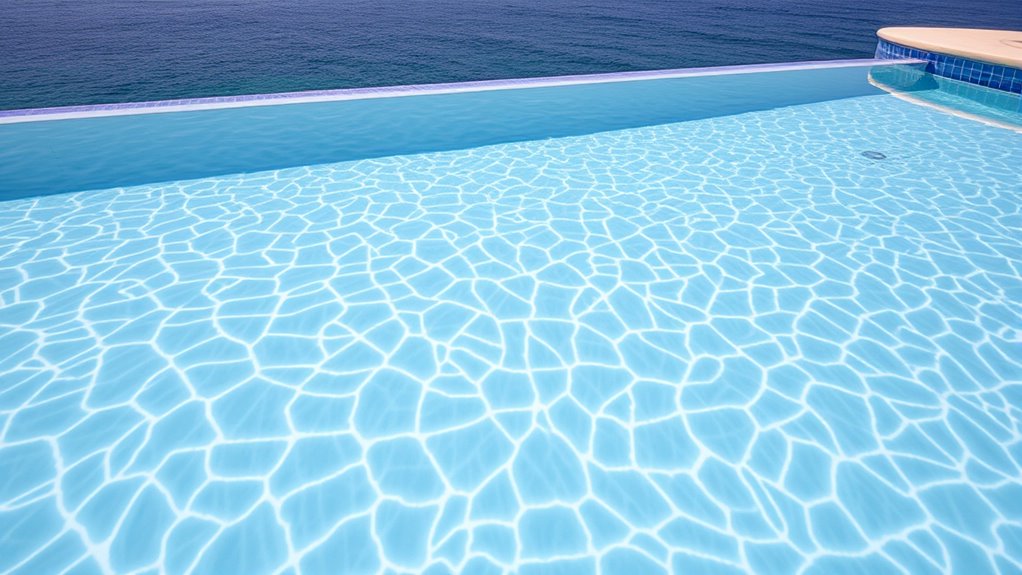
When you keep your LSI (Langelier Saturation Index) levels within the ideal range, you set the stage for long-term pool health and surface integrity. Proper LSI balance prevents corrosion, reduces scaling, and minimizes surface damage. Over time, this maintenance preserves your plaster and tile, saving you costly repairs. Consistently correct LSI levels also:
- Enhance water clarity and comfort
- Extend equipment lifespan
- Reduce chemical consumption
- Minimize algae and bacteria growth
- Improve overall pool safety and aesthetics
Frequently Asked Questions
How Often Should LSI Be Tested in an Infinity Pool?
You should test your infinity pool’s LSI weekly to ensure ideal water chemistry. Regular testing helps you catch imbalances early, preventing damage to the plaster and tile at the edge. Use a reliable test kit to measure pH, alkalinity, and calcium hardness. Adjust chemicals as needed, especially after heavy use or weather changes. Consistent testing keeps your pool in top condition, extending its lifespan and maintaining safe, clear water.
What Are the Signs of LSI Imbalance at the Pool Edges?
You’ll notice signs of LSI imbalance at your pool edges when the plaster or tile shows chipping, cracking, or discoloration. You might also see uneven surface wear, efflorescence, or small areas of delamination. These issues occur because the water’s pH and alkalinity aren’t properly balanced, causing corrosion or scaling. Regular testing helps prevent these problems, so keep an eye on your water chemistry to maintain the pool’s integrity.
Can LSI Adjustments Prevent Tile Discoloration?
Think of LSI adjustments as a shield for your pool’s edge, preventing tile discoloration like a moat guards a castle. By balancing the calcium, pH, and alkalinity levels, you create a harmonious environment that keeps minerals in check. This proactive approach stops staining before it starts, preserving the vibrant look of your tiles. Regularly tuning your LSI is key to maintaining a pristine, lasting finish around your infinity pool.
Is Specialized Equipment Needed to Measure LSI Accurately?
No, you don’t need specialized equipment to measure LSI accurately. You can use simple testing kits or pH strips designed for pool water to get reliable readings. Just follow the instructions carefully, and verify you test your water regularly. Maintaining proper pH, alkalinity, and calcium hardness levels helps you control LSI effectively, protecting your pool’s plaster and tile from damage without the need for expensive or complicated tools.
How Does Weather Impact LSI Levels in Outdoor Infinity Pools?
Weather considerably impacts LSI levels in outdoor infinity pools. Hot, sunny days increase evaporation rates, raising the water’s pH and alkalinity, which can cause scaling. Conversely, cooler or rainy weather lowers evaporation, potentially reducing these levels. Wind can also increase evaporation, affecting water balance. You should regularly test and adjust your pool’s chemical levels to maintain the ideal LSI, especially during extreme weather conditions, to protect your pool’s plaster and tile.
Conclusion
By keeping your LSI balanced, you’re the guardian of your infinity pool’s beauty and durability. Think of it as tending to a delicate masterpiece—you nurture it with care, preventing harm and allowing it to shine endlessly. When you stay vigilant with water chemistry, you’re not just protecting edges; you’re preserving a tranquil oasis that invites serenity and admiration. Embrace this responsibility, and your pool will reward you with timeless elegance and unwavering resilience.
